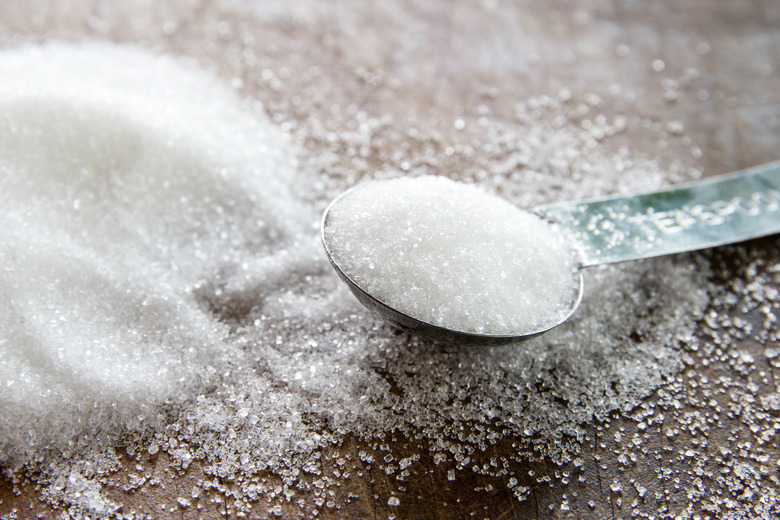The Differences Between Monosaccharides & Polysaccharides
Carbohydrates provide energy and structure to living things. They are made of carbon, oxygen and hydrogen. Monosaccharides comprise the simplest carbohydrates, the building block molecules, and contain single sugar units. Disaccharides are made of two sugar units, and polysaccharides contain several such units. Monosaccharides are rare in nature while polysaccharides are prevalent.
TL;DR (Too Long; Didn't Read)
Monosaccharides and polysaccharides comprise carbohydrates. Monosaccharides are simple sugar unit molecules, whereas polysaccharides are enormous, linking thousands of sugar units. Monosaccharides provide cells with short-term energy. Polysaccharides provide long-term energy storage and rigid structure to cell walls and exoskeletons of animals.
Molecular Features of Monosaccharides and Polysaccharides
Molecular Features of Monosaccharides and Polysaccharides
Monosaccharides contain at least three carbon atoms. Hexoses, the most common monosaccharides, contain six carbons. Examples of hexoses include glucose, galactose and fructose. Glucose represents the chief source for energy in cellular respiration, its small size granting it the ability to enter cell membranes. Fructose serves as a storage sugar. Pentoses contain five carbons (such as ribose and deoxyribose), and trioses contain three carbons (such as glyceraldehyde). Monosaccharides are quite small and form either chain or ring structures. Polysaccharides, however, contain hundreds or even thousands of monosaccharides and a high molecular weight.
Energy Availability and Storage
Energy Availability and Storage
While monosaccharides such as glucose provide short-term energy, polysaccharides provide longer storage of energy. Cells use monosaccharides quickly. The molecules can bond to cell membrane lipids and aid in signaling. But for longer storage, monosaccharides must be converted to either disaccharides or polysaccharides via condensation polymerization. The polysaccharides become too large to cross a cell membrane, hence their storage capability. Starches represent polysaccharides used by plants and their seeds to store energy. Starches are made of the glucose polymers, amylose and amylopectin. Polysaccharides can be broken down or hydrolyzed in the cell, as energy is needed in the form of monosaccharides. This is how animals use plant starches to make glucose for metabolism.
Polysaccharide Structures and Functions
Polysaccharide Structures and Functions
Cellulose, the most abundant polysaccharide and organic molecule, may contain 50 percent of the world's carbon. The base monosaccharide of cellulose is glucose. The straight cellulose molecules make up rows in a stable form via the weak but prevalent hydrogen bonds between them. Made by plants, fungi and algae, cellulose provides the rigid structure of plant cell walls, which also protect against diseases. Many animals cannot digest cellulose, but those that can use intestinal micro-organisms and enzymes for the task. Fermentation occurs in the colon of other animals and humans that cannot digest cellulose. Animals produce a similar polysaccharide, chitin, made from a modified monosaccharide. Chitin comprises exoskeletons. Both cellulose and chitin make up compact energy storage units.
Another polysaccharide, glycogen, can be broken down from its compact form quickly into its constituent glucose monosaccharides. Humans store glycogen as a rapid energy source in the liver and muscles. Pectins, arabinoxylans, xyloglucans and glucomannans represent additional complex polysaccharides. Monosaccharides are soluble in water, but many polysaccharides have poor water solubility in water. Polysaccharides can form gels, depending on their solubility. This is why they are often used to thicken foods.
The Importance of Monosaccharides and Polysaccharides
The Importance of Monosaccharides and Polysaccharides
Both monosaccharides and polysaccharides provide energy. The monosaccharides yield energy quickly for cells, while polysaccharides provide longer energy storage and structural stability. Both are essential to all living things as the largest source of food and food energy. Polysaccharides from cell walls make up the fiber humans eat, while monosaccharides provide the sweetness in foods. As humans eat, chewing breaks down polysaccharides into smaller particles that eventually, through digestion, yield up the simple monosaccharides that can pass into the bloodstream.
References
- Royal Society of Chemistry: Carbohydrates
- Dallas County Community College District: Carbohydrates
- Elmhurst College: Virtual Chembook: Carbohydrates
- University of Miami Department of Biology: The Molecules That Make Plant Cells...Different
- Brooklyn College BIOdotEDU: Polysaccharides
- Critical Reviews in Food Science and Nutrition: Role of Polysaccharides in Food, Digestion, and Health
Cite This Article
MLA
Hermance, Dianne. "The Differences Between Monosaccharides & Polysaccharides" sciencing.com, https://www.sciencing.com/differences-between-monosaccharides-polysaccharides-8319130/. 30 April 2018.
APA
Hermance, Dianne. (2018, April 30). The Differences Between Monosaccharides & Polysaccharides. sciencing.com. Retrieved from https://www.sciencing.com/differences-between-monosaccharides-polysaccharides-8319130/
Chicago
Hermance, Dianne. The Differences Between Monosaccharides & Polysaccharides last modified March 24, 2022. https://www.sciencing.com/differences-between-monosaccharides-polysaccharides-8319130/
